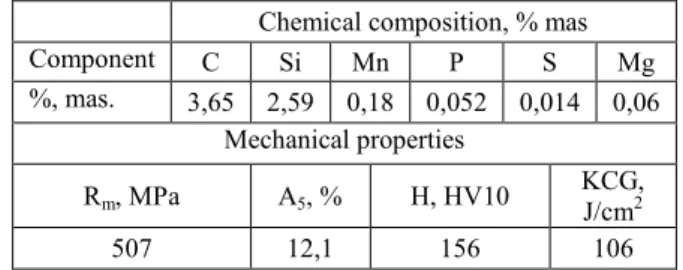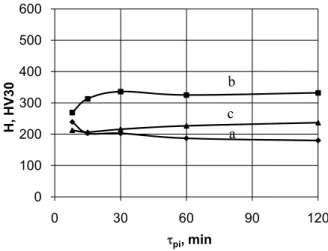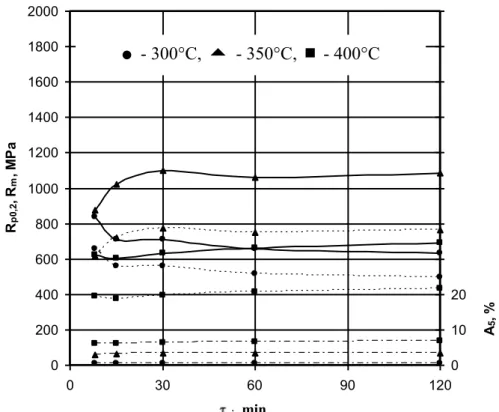A R C H I V E S
o f
F O U N D R Y E N G I N E E R I N G
Published quarterly as the organ of the Foundry Commission of the Polish Academy of Sciences
ISSN (1897-3310) Volume 9 Issue 3/2009
267 – 274
48/3
Predicting ADI mechanical properties
T. Giętka*,
S. Dymski
Department of Materials Science and Engineering, Mechanical Engineering Faculty University of Technology and Life Sciences, al. Kaliskiego 7, 85-796 Bydgoszcz, Poland
*Corresponding author. E-mail address: tgietka@utp.edu.pl
Received 21.04.2009; accepted in revised form 24.04.2009
Abstract
Ductile cast iron was quench-hardened with the isothermal transformation according to two alternatives. The first treatment alternative consisted in the austenitizing process at temperature t = 830, 860 i 900°C and annealing at temperature tpi = 400, 350 and 300°C in a
pe-riod of time up to 240 min. The second treatment alternative consisted in dual-stage austenitizing. The material was annealed in temperature of t = 950°C and cooled to temperature t’ = 900, 860 and 830°C. The isothermal transformation was performed in the same conditions as in the first alternative.
The cast iron was ferritizingly annealed before the isothermal quench-hardening. The cast iron matrix after the annealing was ferritic.
Metallographic cubic specimens with the size about of 10 mm were quench-hardened with the isothermal transformation. Matrix micro-structure, austenite percentage and Vicker’s hardness were determined using the specimens. Hardness test results were used to determine, on the base of material coefficients, tensile strength Rm, yield strength Rp0,2 and deformation A5.
Tests showed that heat treatment according to two alternatives of the quench hardening led to obtain ADI cast iron with accordance to PN– EN 1564 : 2000 grade: EN-GJS-800-8, EN-GJS-1000-5, EN-GJS-1200-2. Only ausferritic cast iron was assumed as a base of qualifica-tion.
Keywords: Austenitizing, Isothermal transformation, Properties
1. Introduction
Relations describing influence of hardness on steel strength and plasticity have been known for a very long time. Descriptions are based on mathematical formulas but they are only connected with only one technological state.
Producing castings from ADI cast iron, there is applied quench hardening with the isothermal transformation in order to create high-carbon austenite and ferrite saturated with carbon in the ma-trix. Such a constant of microstructure is called ausferrite, and the process of the isothermal transformation of precooled austenite is called ausferritising [4 ÷ 6].
The matrix microstructure consisting of austenite and ferrite is important in the ADI high-grade cast iron technology [1 ÷ 3].
homogenize the metal matrix and enrich austenite with carbon. During heating of the cast iron to austenite carbon atoms, coming from emissions of graphite, diffuse. The metal matrix austenitising process and the role of graphite in its carbonizing were presented in the paper [7].
Austenitizing usually takes places in range of 815 ÷ 950°C. The effect of austenitising depends on the chemical composition of the matrix, the input structure of cast iron before quench hardening, emissions of graphite, temperature and time of warming, and on homogenity of elements in eutectic grains also and growth of grains.
The investigation aimed at predicting of strength and plasticity of ADI ductile cast iron on the base of its hardness tests. Whereas obtained test results in comparison with experimental tests results performed in source works might be an essential piece of engineer-ing processes durengineer-ing material designs.
2. Material, program and methodology
of investigations
The investigated ductile cast iron was smelted in a hot blow industrial acid cupola. The spheroidization of cast iron was per-formed by the ML5 magnesium-alloy by means of the rod method in a reservoir of the cupola. The cast iron was cast to moist sand forms. The casts had the YII ingot shape according to (PN - EN 1563:2000). The cast ductile iron was classified to species EN - GJS-500-7 basing on the static tensile test. The cast iron was characterized by the ferrite - pearlite (10 % pearlite) structure of the matrix and the correct nodular graphite form (11,5 % graphite on surface, 112 precipitations/ mm2 of the micro section).
The chemical composition and properties of the plain cast ductile iron are presented in the table 1.
Table 1.
The chemical composition and mechanical properties in ductile iron
Chemical composition, % mas
Component C Si Mn P S Mg
%, mas. 3,65 2,59 0,18 0,052 0,014 0,06 Mechanical properties
Rm, MPa A5, % H, HV10
KCG, J/cm2
507 12,1 156 106
Lower cuboidal parts of YII specimens were ferritizingly an-nealed according to the scheme presented in the paper [17]. Next the ingots were cut into three flat bars. Keeping the sequence of the position of the cut from the ingot flat bars they were marked and cut into 54 specimens with dimensions of 10x10x10 mm.
Metallographic specimens were quench-hardened with the isothermal transformation according to schemes presented in fig. 1 and 2. One specimen was prepared for the each alternative treatment.
Fig. 1. Quench hardening with the isothermal transformation of ductile cast iron according to the alternative I
Fig. 2. Quench hardening with the isothermal transformation of ductile cast iron according to the alternative II
In order to evaluate the microstructure micro sections were done on heat treated specimens. That test was a base for qualifica-tion. Consequently to predict chosen mechanical properties quench hardened specimens with the isothermal transformation in time τpi= 8 ÷ 120 min were used because the matrix of cast iron
consisted of ausferrite.
The hardness test was performed with the usage of the
HPO 250 durometr with loading 294 N. The results of Vicker’s
hardness were exchanged by means of comparison tables into
Brinell’s one.
For the purpose of diagrams’ plotting and determination of the
mathematical relationships, among HB hardness and Rm, Rp0,2 and
3. The results of investigations and their
analysis
The results of investigations of hardness as function of time
of isothermal precooling are showed on the figures 3 ÷ 8.
Fig. 3. The influence of ausferritizing time on hardness of the har-dened cast iron according to the alternative I form temperature
t = 830°C and at temperature tpi: a) 300, b) 350 and c) 400°C
Fig. 4. The influence of ausferritizing time on hardness of the har-dened cast iron according to the alternative II form temperature t = 950°C and t’ = 830°C and at temperature tpi: a) 300, b) 350
and c) 400°C
Fig. 5. The influence of ausferritizing time on hardness of the har-dened cast iron according to the alternative I form temperature
t = 860°C and at temperature tpi: b) 350 and c) 400°C
Fig. 6. The influence of ausferritizing time on hardness of the har-dened cast iron according to the alternative II form temperature t = 950°C and t’ = 860°C and at temperature tpi: a) 300, b) 350
and c) 400°C
0 100 200 300 400 500 600
0 30 60 90 120
H,
HV30
pi, min
0 100 200 300 400 500 600
0 30 60 90 120
H,
HV
30
pi, min
0 100 200 300 400 500 600
0 30 60 90 120
H
,
H
V
30
pi, min
0 100 200 300 400 500 600
0 30 60 90 120
H,
HV30
pi, min
b
c a
a
b c
b c
a
Fig. 7. The influence of ausferritizing time on hardness of the har-dened cast iron according to the alternative I form temperature
t = 900°C and at temperature tpi: a) 300, b) 350 and c) 400°C
Fig. 8. The influence of ausferritizing time on hardness of the har-dened cast iron according to the alternative II form temperature t = 950°C and t’ = 900°C and at temperature tpi: a) 300, b) 350
and c) 400°C
From diagrams 4-7 it can be unequivocally stated that gradual austenitizing (treatment alternative II) essentially influences hardness of cast iron. Hardness of specimens quench hardened according the the alternative II is bigger then heat treated accord-ing to the alternative I.
Basing on material coefficients (1), (2) and (3) the values of tensile strength Rm, yield strength Rp0,2 and deformation A5 were
calculated. Values of material coefficients were determined on the base of minimum values of Rm, Rp0,2 and A5 of ADI cast iron
included in the PN-EN 1564 : 2000 standard.
m
R
H
m
(1)m p
R
R
p
0,2 (2)%
100
5
H
A
q
(3)where:
-
H
- hardness [HB],-
R
m - tensile strength [Mpa],-
R
p0,2 - yield strength [Mpa],-
A
5 - deformation [%].The values of mechanical properties result direct from the temperature tpi, so for predicting were assumed material
coeffi-cients which are presented in the table 2.
Table 2.
Values of material coefficients assumed for individual tempera-ture tpi
Coefficient Isothermal transformation temperature,°C
300 350 400
m 0,271 0,291 0,325
p 0,786 0,705 0,625
q 0,263 1,094 3,077
Results of tensile strength Rm, yield strength Rp0,2 and
defor-mation A5 for individual conditions of quench hardening
accord-ing to alternatives I and II were presented in fig. 9-14.
0 100 200 300 400 500 600
0 30 60 90 120
H,
HV30
pi, min
0 100 200 300 400 500 600
0 30 60 90 120
pi, min
H
,
H
V
3
0
a
b c
a
b
Fig. 9. The influence of ausferritizing time on Rp0,2, Rm, i A5 of quench hardened cast iron according to the alternative I form temperature
t = 830°C
0 200 400 600 800 1000 1200 1400 1600 1800 2000
0 30 60 90 120
pi, 0C
Rp
0
,2
, R
m
,
M
P
a
0 10 20 30 40 50 60 70 80 90 100
A5
, %
0 200 400 600 800 1000 1200 1400 1600 1800 2000
0 30 60 90 120
pi, 0C
Rp
0
,2
, R
m
,
M
P
a
0 10 20 30 40 50 60 70 80 90 100
A5
, %
- 300
°C
,
- 350
°C
,
- 400
°C
- 300
°C
,
- 350
°C
,
- 400
°C
pi, minFig. 11. The influence of ausferritizing time on Rp0,2, Rm, i A5 of quench hardened cast iron according to the alternative I form temperature
t = 8600C
0 200 400 600 800 1000 1200 1400 1600 1800 2000
0 30 60 90 120
pi, 0
C
R
p
0
,2
, R
m
,
M
P
a
0 10 20 30 40 50 60 70 80 90 100
A5
, %
200 400 600 800 1000 1200 1400 1600 1800 2000
Rp
0
,2
, R
m
,
M
P
a
10 20 30 40 50 60 70 80 90 100
A5
, %
- 300
0C,
- 350
0C,
- 400
0C
- 300
°C
,
- 350
°C
,
- 400
°C
Fig. 13. The influence of ausferritizing time on Rp0,2, Rm, i A5 of quench hardened cast iron according to the alternative I form temperature
t = 900°C
0 200 400 600 800 1000 1200 1400 1600 1800 2000
0 30 60 90 120
pi, 0C
Rp
0
,2
, R
m
,
M
P
a
0 10 20 30 40 50 60 70 80 90 100
A5
, %
0 200 400 600 800 1000 1200 1400 1600 1800 2000
0 30 60 90 120
pi, 0
C
R
p
0
,2
, R
m
,
M
P
a
0 10 20 30 40 50 60 70 80 90 100
A5
, %
- 300
°C
,
- 350
°C
,
- 400
°C
- 300
°C
,
- 350
°C
,
- 400
°C
pi, min
4. Conclusions
Quench hardening with the isothermal transformation, accord-ing to alternatives I and II, was evaluated on the base of predic-tion of chosen mechanical properties of ADI. Parameters of heat treatment were attributed to suitable cast iron grades (table 3).
Table 3.
ADI grades classified with accordance to PN-EN 1564 after quench hardening according to alternatives I and II
Temp. tpi,°C
Time
pi, min
Heat treatment
Alternative I Alternative II
830 860 900 830 860 900
400
8
15
30
60
350
8
15
30
60
300
8
15
30
60
- EN – GJS – 800 – 8, - EN – GJS – 1000 – 5,
- EN – GJS – 1200 – 2, - EN – GJS – 1400 – 1 From the table 3 results that high-strength grades (1200, 1400 MPa) can be obtained by quench hardening according to the alternative II 300, 350°C. Grades (800, 1000 MPa) – in tempera-ture 400°C. Isothermal quench hardening according to the alterna-tive I would let to obtain ADI cast iron – all grades, only after austenitizing in temperature 900°C.
Experimental investigations to verify the predicted mechani-cal properties will be continued.
Acknowledgements
This work was carried out with the financial support of the Minis-try of Science and Higher Education under grant No. N508 389335.
References
[1] S. Pietrowski, Nodular cast iron of bainitic ferrite structure with austenite or bainitic structure, Archives of Materials Science, vol.18, No 4, (1997) 253-273 (in Polish).
[2] S.E. Guzik, Austempered cast iron as a modern constructional
[4] B.V. Kovacs, On the Terminology and Structure of ADI, AFS Transactions, vol. 102 (1994) 417-420.
[5] S. Dymski, Z. Ławrynowicz, T. Giętka, Impact strength of ADI, Archives of Foundry, vol. 6, No. 21 (1/2) (2006) 369-376 (in Polish).
[6] V. Kilicli, M. Erdogan, The Strain-Hardening Behavior of Partially Austenitized and the Austempered Ductile Irons with Dual Matrix Structures, Journal of materials Engineer-ing and Performance, vol. 17, No. 2 (2008) 240-249. [7] M. Delia, M. Alaalam, M. Grech, Effect of Austenitizing
Conditions on the Impact Properties of an Alloyed Austem-pered Ductile Iron of Initally Ferritic Matrix Structure, vol 7, No. 2 (1998) 265 – 272.
[8] M. Grech, J.M. Young, Effect of austenitising temperature on tensile properties of Cu-Ni austempered ductie iron, Mate-rials Science and Technology, vol. 6 (1990) 415-421. [9] J. Mallia, M. Grech, Efect of silicon content on impact
prop-erties of austempered ductile iron, Materials Science and Technology, vol. 13 (1997) 408-414.
[10]T. Szykowny, Isothermal eutectoidal transformation in duc-tile cast iron EN-GJS-500-7, Archives of Foundry, vol. 5, No. 17 (2005) 303-312 (in Polish).
[11]T. Szykowny, J. Sadowski, X-ray study of eutectoidal trans-formation in cast iron EN-GJS-600-03, Archives of Foundry, vol. 5, No. 17 (2005) 247-252 (in Polish).
[12]K. Ogi, A. Sawamoto, Y.C. Jin, C.R. LoperJr., A study of Some Aspects of the Austenitization Process of Spheroidal Graphite Cast Iron, AFS Transactions vol. 96 (1988). [13]J. Aranzabal, I. Gutierrez, J.M. Rodriguez-Ibabe, J.J. Urcola,
Influence of the Amount and Morphology of Retained Aus-tenite on the Mechanical Properties of an Austempered Duc-tile Iron, Metallurgical and Materials Transactions, vol. 28A, (1997) 1143-1156.
[14]Z. Ławrynowicz, S. Dymski, Mechanism of bainite transfor-mation in ductile iron ADI, Archives of Foundry Engineer-ing, PAN, vol.6, No 19, (2006) 171-176.
[15]O. Eric at al., The austempering study of alloyed ductile iron, -622.
[16]L.C. Chang, Carbon content of austenite in austempered ductile iron, Scripta Materialia, vol.39, No 1, (1998) 35-38. [17]S. Dymski, T. Giętka, Influence of gradual austenitizing on
chosen properties of ADI, Archives of Foundry Engineering, vol.8, issue 3, July – September (2008) 185-190.
[18]D. Kaszowski, Master’s degree dissertation, Structure and hardness of ADI cast iron after heating in variable quench hardening temperature, University of Technology and Life Sciences in Bydgoszcz (2008).
[19]R. Gąciarz, Master’s degree dissertation, Influence of quench hardening with the isothermal transformation on structure and hardness of ductile cast iron, University of Technology and Life Sciences in Bydgoszcz (2008).





